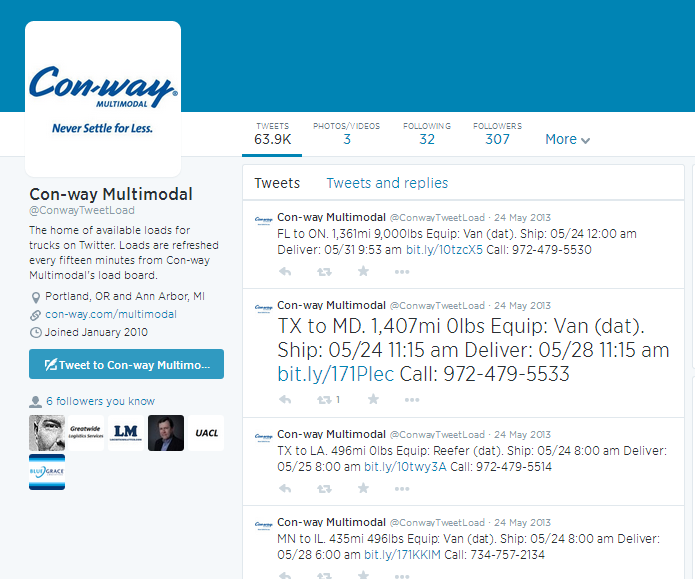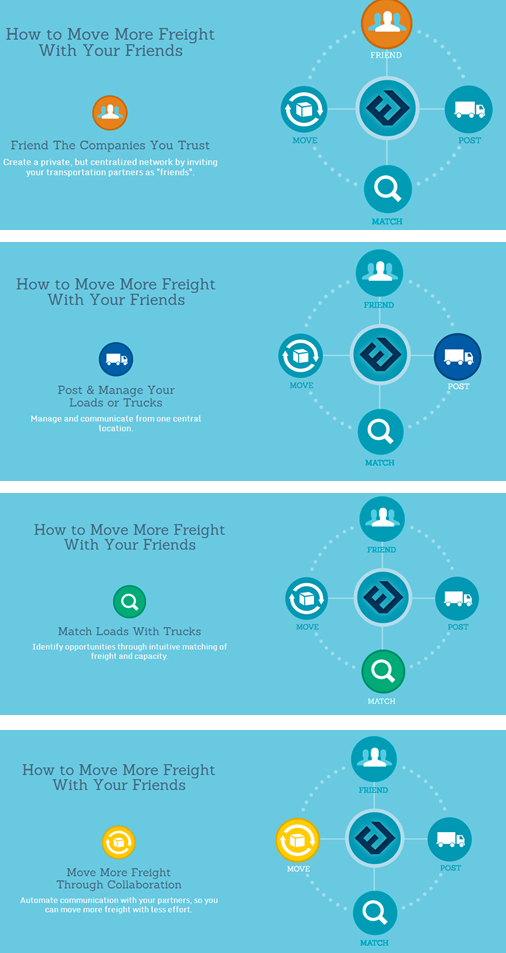
by Fronetics | Jun 9, 2014 | Blog, Marketing, Social Media, Strategy, Supply Chain, Transportation & Trucking
Many companies within the logistics and supply chain industries are stuck on the social media starting line. The reason – “they can’t get past the word ‘social’ and the perception it creates.” The reality is that social media is a tool that can be utilized to create value and grow your business.
This is the second in a series of articles that provides examples of companies within the logistics and supply chain industries who have moved beyond the social media starting line and have realized the business value of participating in social media.

Long-haul truck drivers are more likely to be overweight or obese than the general public (86% v. 65%). Additionally, truck drivers are more likely to smoke, have high blood pressure, and suffer from sleep apnea than the general public. The poor health of long-haul truckers is largely due to their lifestyle. Long-haul trucking is a sedentary lifestyle. It is also a lifestyle which makes it challenging to access gyms and healthy foods.
The cost of poor health is enormous – for truckers and for their employers. The estimated annual health care costs of obesity-related illness are $190.2 billion, or nearly 21 percent of annual medical spending in the United States. Looking specifically at the trucking industry – a study published in the Journal of Occupational and Environmental Medicine found that obese truckers had an annual average total health care cost of $1,944, compared with $1,755 for overweight truckers and $1,131 for normal-weight drivers. A sleep apnea screening and treatment program conducted by Schneider National identified 350 drivers who required treatment. Treating these drivers not only improved their health, but it also improved the company’s bottom line – over a one year period, Schneider National saved $530 per month per driver in insurance costs and saw a 71 percent reduction in accidents involving those drivers during the same period.
An article in Today’s Trucking shares the story of Jason Janneta a 42 year old trucker who had been driving for 20 years and was a poster boy for the statistics – overweight and unhealthy. Fed up, he decided to make a lifestyle change. Within six months of embracing a healthier lifestyle he had lost 80 pounds. During this period he had also taken to Twitter to share his experience and to motivate other truckers to adopt a healthier lifestyle, lose weight, and improve their health.
Tweeting as @urbanhauler with #fittrucker, Jannetta captured the attention of other truckers (he quickly grew his followers to more than 1,500) and the attention of Jared Martin, the President of Speedy Transport.
Martin recognized the value of Jannetta’s efforts and of #fittrucker – healthier individuals, a healthier bottom line, and opportunity to attract new drivers.
According to Martin:
“I really enjoyed a lot of his posts and what he was trying to do for the industry, so we brought him in for a meeting.”
The two discussed the role of health and fitness on the future of the transportation industry. The next day, Martin offered Jannetta a job at Speedy Transport – Driver Trainer and Wellness Advisor. Martin accepted the position and now tweets for @speedywellness where he brings “#trucking and #fitness/#wellness together.”
Speedy Transport is one company which has recognized social media as a business tool and has moved far beyond the social media starting line. The Twitter profile of @speedywellness rightly points out “we #ChangeTheGame of #Trucking.”

by Fronetics | Jun 3, 2014 | Blog, Marketing, Social Media, Strategy, Supply Chain, Transportation & Trucking
Many companies within the logistics and supply chain industries are stuck on the social media starting line. The reason – “they can’t get past the word ‘social’ and the perception it creates.” The reality is that social media is a tool that can be utilized to create value and grow your business.
Over the next four weeks I will be providing examples of companies within the logistics and supply chain industries who have moved beyond the social media starting line and have realized the business value of participating in social media.
Using social media to move freight
Transportation logistics is vital to the supply chain and logistics industries. For companies within these industries; however, transportation logistics can prove to be challenging to navigate and can prove challenging to the bottom line.
MercuryGate International Inc. and Con-way Inc. are two companies that have used social media to turn transportation logistics on its head – they use social media to move freight.
TweetLoad
Con-way Multimodel, a division of Con-way Inc., launched TweetLoad™ in 2010. TweetLoad enables carriers to access available loads from Con-Way Multimodel via Twitter. Carriers who follow @ConwayTweetLoad on Twitter are able to see the latest available shipments as well as links to additional information on the company’s link board. Load information is updated on Twitter every 15 minutes, meaning that carriers who follow @ConwayTweetLoad have real-time information on available loads.
Figure 1: Conway TweetLoad

Bill Graves, president, American Trucking Associations (ATA): “With this novel use of Twitter, Con-way Multimodal is leading the industry in maximizing the best features of new technology to improve their processes. This is a great example of how innovative transportation companies can make it easier for carriers to do business with them, which will be a benefit to our industry overall.”
View a YouTube demonstration of TweetLoad at www.youtube.com/watch?v=0zL7h7kTU1M.
Freight Friend
In 2011 MercuryGate International Inc. launched Freight Friend. Freight Friend is a free relationship-based full-featured load and truck internet posting service for shippers, brokers and carriers. Freight Friend creates a private network between transportation partners, and utilizes technology to automatically identify appropriate matches. The combination of the technology utilized and the relationship-based nature of Freight Friend allows companies to have real-time visibility to book trucks and find freight with companies they trust.
The Freight Friend concept is shown in Figure 2.
Figure 2: Freight Friend

“FreightFriend is perfect for carriers, shippers, brokers, 3PLs and freight management firms who only want to share information with companies they trust. They can keep their current information in one place, knowing that friends – and only friends – will have constant access. While public load boards fill a real need, they come at a cost – a lot of unknown companies bidding to carry the freight. Private boards are often useful too, but they’re inconvenient to carriers with multiple clients asking them to check their bid portals. FreightFriend solves the dilemma with a single service where carriers can easily communicate with all of their clients and brokers can find available capacity from carriers they trust.”
Freight Friend is fully integrated into MercuryGate’s TMS and Carrier Management System (Carma). Freight Friend is also available to integrate with other TMS providers.

by Fronetics | May 25, 2014 | Blog, Logistics, Marketing, Social Media, Strategy, Supply Chain
Some companies within the logistics and supply chain industries have chosen to participate in social media while others have not. Why have some companies chosen not to participate while others have decided to participate? What social networks do companies within the logistics and supply chain perceive to provide the most value to their business? What challenges do companies face with respect to social media?
Fronetics Strategic Advisors aims to gain insight into these questions and more. We are conducting a survey on social media within the logistics and supply chain industries. The objective of the survey is to learn about the participation and use of social media within the logistics and supply chain industries.
The survey is aimed at companies within the logistics and supply chain industries, and takes only about 5 to 10 minutes to complete.
This survey is confidential. Responses will be reported in aggregate and no individual- or company-identifiable information will be shared with anyone.
If your company is part of the logistics or supply chain industries please take the time to take the survey.


by Fronetics | May 19, 2014 | Blog, Content Marketing, Marketing, Social Media, Strategy
The internet is a fire hose stream of content. Being able to navigate the deluge of content and identify the content that is valuable to your customers and to your business is essential; it can also be incredibly time consuming. Content curation tools can save time and increase productivity.

Here are 11 content curation tools that will help you establish your business as a thought-leader and trusted resource.
Bundle Post
With Bundle Post you connect and control Alerts and RSS feeds based on keywords. Bundle Post saves the content from your feed channels as a social media post, allowing you to view, edit or delete the content within the channel, all in one place, then merge selected curated content with scheduled posting times you create for each of your social media accounts and networks. Bundle Post offers a free 30 day trial. After that subscriptions start at $19.99 per month.
ContentGems
ContentGems monitors more than 200,000 news sites, blogs, and social media accounts. With ContentGem you can filter content a number of different ways including: custom keywords, sources, and media types. With ContentGems it is easy to share content via social media (one-click publishing and the ability to schedule posts). Freemium and premium options available.
feedly
feedly enables you to organize, read and share the content of your favorite feeds, blogs and news sites. If you liked Google Reader, feedly fills that gap. Free and premium versions available.
iFlow
iFlow allows users to discover, create, and curate ‘flows’ on any topic. Flows are topic-based streams that let users stay connected and updated with selected topics. These ‘flows’ may be followed, which results in users being continually updated with content relevant to selected topics. Flows can be set up to include detailed filters to provide for high quality of content curation. iFlow also allows users to create their own private flows. Users may invite others to contribute on their flows or can even keep their flows private. iFlow is free.
Individurls
Individurls is quite similar to feedly. One of the strengths of this content curation is how easy it is to use on your mobile phone. Individurls is free.
Netvibes
Although Netvibes is one of the original content curation tools, it remains a solid (and not outdated) solution. Netvibes offers a number of ready-made feeds and widgets. Both freemium and premium versions are available.
Newsle
Newsle is a great tool to keep you on top of what is happening with people within the industry and within your social network. It is also a great tool if there are specific writers or journalists whose content you want to keep track of. With Newsle you identify the people and Newsle sends you an email when those individuals are mentioned in the news.
paper.li
paper.li enables you to create your own online newspaper based on content you select. You add various sources and specify filters on these sources and a paper is produced. You can then add or remove “articles” from the paper. While paper.li can be used for free, the paid version allows you to brand your newspaper.
Post Planner
Post Planner is a solution for those who are avid Facebook users; PostPlanner is a Facebook app. With PostPlanner you enter in keywords and search for trending content within your niche. You can then sort this content to view the content with the most likes or shares so you can see the most popular content. While PostPlanner does offer a free version, to get the most from this tool you will need to upgrade to one of the premium packages.
Scoop.it
Scoop.it offers users a great experience and a constant stream of content. Scoop.it automatically finds and features comment from places like Twitter and Google blogs based on your target keywords and interests. It is also customizable, allowing for additional sources to be added to your stream(s). In Scoop.it you create boards of content around specific topics and then add content to these boards. Scoop.it allows for one-click publishing to your blog and social networks. Scoop.it offers a free trial, after that plans start at $12.99 per month.
Trapit
Trapit positions itself as a “smart” curation tool, increasing in intelligence and relevance the more you use it. It features more than 100,000 vetted content sources and includes “hidden gems” that have the potential to make your presence stand out. How does it do this? Trapit uses the same Artificial Intelligence and Machine Learning Technology from which Siri is derived.
by Fronetics | May 15, 2014 | Blog, Consumer Electronics, Content Marketing, Marketing, Social Media, Strategy, Supply Chain
Curating content is an essential component of your content strategy and to demand generation. Content curation can help you grow your business by establishing your business as a thought-leader within the industry and as a trusted resource.
Here are four factors to doing content curation successfully:
Know your audience
Identify your audience. In many cases your target audience is your company’s buyer persona.
Take the time to know your audience. For example, take the time to understand what type of information and/or resources they are likely to be looking for, learn what platform(s) they are most likely to use (e.g. Twitter, LinkedIn, Facebook), learn their interests, and learn their passions.
Be relevant
Curate content that is relevant to your audience. The content you curate should provide your audience with value and knowledge.
Quality, quality, quality
Content can be stuff. Content can be clutter. If you want the content your business curates to stand out, you make sure the content you curate is quality – every time. Quality is a differentiator.
Be consistent
Share content on a regular and consistent basis. This will not only increase your visibility, but it will also establish you as a trusted resource – as the go-to resource for information and for knowledge.
This article also appeared on DC Velocity.
by Fronetics | May 12, 2014 | Blog, Content Marketing, Marketing, Social Media, Strategy
Adam Robinson of freight logistics company Cerasis wrote a series of posts which outlined the company’s social media and content marketing strategy and the successes the company has achieved through the execution of their strategy. The series also included how-to guides: how to create a social media and content marketing strategy and how to execute a social media and content marketing strategy. Robinson’s series is a must read for companies interested in learning the potential business value of a social media and content marketing strategy and for companies wondering the steps they need to take to create and execute a successful strategy.
Two sentences in Robinson’s series stand out:
“It all comes down to strategy!”
“Now, if you have the resources to be on every social media platform, you should, but only if you do it well!”
Sage advice.
Without a strategy it is unlikely that your company will be successful. Social media and content marketing can be effective tools for attracting new customers and retaining current customers; however, it is unlikely that your company will reap these benefits if you do not have a strategy in place. A 2014 study shows just how important strategy is. The study found that 60 percent of companies with a documented strategy in place consider their efforts to be effective as compared to 11 percent of companies with no documented strategy in place.
A successful strategy takes into consideration your company’s strengths, resources, limitations, and goals. Another component of success – doing things well. For some companies it is possible (and makes sense) to be on every social media platform. For many companies a well-executed strategy means focusing on one or two platforms. Don’t spread yourself thin, make your company show up strong!
It is also important to remember that if you need help, there is help available. It is possible to obtain training in social media and content marketing and it is possible to outsource these functions.
This article also appeared on DC Velocity.





